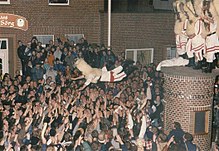Klaasohm
Klaasohm is a custom on the North Sea island of Borkum , which probably goes back to the time of the whalers , and is celebrated on the night of December 5th to 6th . Variants of Klaasohm can be found under different names on the Dutch wadden islands .
origin
The name "Klaasohm" means Ohm (uncle) Klaas (Klaus). In the Klaasohmfest, elements of St. Nicholas' customs, as it is also known from the mainland, mix with strange sprinkles, possibly set pieces of much older tradition and influences that were brought from outside. The Nikolausfest is the only saints festival that has taken place in the Reformed part of East Friesland and even flourished there. It may have contributed to the fact that Saint Nicholas of Myra was venerated as the patron saint of seafarers and as an emergency helper against water shortages.
In the time when whaling was still practiced from Borkum , the men were mostly out on the high seas for months. The whalers did return home at the beginning of December at the latest, but mostly much earlier for the winter break, so that the celebration of the return from the long exertions on the high seas was probably only a minor aspect.
Some sources claim that the rite arose from the "reconquest" of the island from the women who took over "power" in the families during the long absence of the whalers. They would now have to submit to the men who had returned, which they demonstrated emphatically with a blow on the buttocks of the women.
Practice of customs
During the night, six young men from the Borkumer Jungens club dressed as "Klaasohm" walk around the island - two small, medium and large as well as another in the role of Wiefke, who accompanies the great Klaasohm. Which young men go around as Klaasohms is only communicated to them at the last moment and is kept strictly secret.
After the Klaasohms of the three groups have been dressed in different places, they move with their companions to the large operating hall of the Borkum Kleinbahn , in which a stage has been set up, to which women and strangers are excluded (only men born in Borkum are allowed in ) in ritualized battles it will be decided who will take the lead for this year - the defined distribution of roles is not changed. Then the train across the island begins, with great sympathy from the population.
The Klaasohms wear barrel-shaped helmets up to one meter high, covered with sheep's clothing, and pasted with feathers and seagull wings. In addition to small eye openings, the helmets also have a drinking opening. The cow horn with which the Klaasohms are equipped is used to hit young women on the rump. Since the Klaasohm sees little himself, he has a guide who shows him the right way and several catchers who help him to catch the young women. Young women who had to endure lashes from a Klaasohm receive moppe, a kind of hard honey cake . The Klaasohm is friendly towards children and mothers - they are given mops and petted. In addition to the Klaasohms, Klaasohm is also affected by Wiefke, a young man disguised as a woman who is particularly wild. The move of the Klaasohms traditionally ends in the center of the village, on a square named after its shape “D” , which is the center of an intersection. On this square there is an advertising pillar , from the flat top of which all “Klaasohms” and finally “Wiefke” rush into the crowd below, where they are always caught by many poor people. Before jumping into the crowd, the individual Klaasohms and mostly Wiefke are celebrated by the audience.
Variants of the custom in the Netherlands
On the inhabited islands in the Dutch Wadden Sea, traditional festivals similar to Klaasohm are celebrated around December 5th: Klozum on Schiermonnikoog , Sunneklaas on Ameland , Sunderum on Terschelling and Opkleden on Vlieland . Ouwe Sunderklaas will take place on Texel on December 12th .
Individual evidence
- ↑ Deutsche Welle: " Klaasohm rules on Borkum "
- ↑ Borkumer Zeitung from 1958 (without further details)
- ↑ Mystical custom on the Frisian islands. Burkana - The maritime magazine No. 26, 2012 p. 8
- ↑ Mystical custom on the Frisian islands. Burkana - The maritime magazine No. 26, 2012 pp. 8-10
